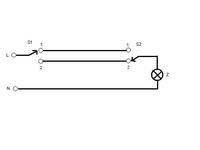Hello
I would like to connect 2 motion sensors to the staircase switch, 1 at the bottom and 1 at the top. I just want to consult so as not to burn out the detectors. Well, the thing about a staircase switch is that I turn it on at the bottom and turn it off at the top. And it would be most convenient for me to connect at the bottom to the box or the staircase switch, and at the top only to the switch. I just don`t know how because there are 3 wires. black where there is constant voltage, blue is voltage when the light is on and yellow-green is voltage when it is turned off. although when the tester is turned on, it glows slightly yellow-green. And now I have a question about how to connect to these wires.
I would like to connect 2 motion sensors to the staircase switch, 1 at the bottom and 1 at the top. I just want to consult so as not to burn out the detectors. Well, the thing about a staircase switch is that I turn it on at the bottom and turn it off at the top. And it would be most convenient for me to connect at the bottom to the box or the staircase switch, and at the top only to the switch. I just don`t know how because there are 3 wires. black where there is constant voltage, blue is voltage when the light is on and yellow-green is voltage when it is turned off. although when the tester is turned on, it glows slightly yellow-green. And now I have a question about how to connect to these wires.




